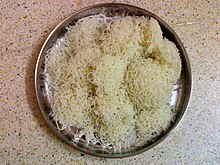Idiappam

Cooked idiyappams on a plate
|
|
| Type | breakfast |
|---|---|
| Place of origin | India |
| Main ingredients | rice flour |
| Similar dishes | Putu mayam |
| |
|
Idiyappam (Tamil: ),(Malayalam: ), (Sinhalese: ඉඳි ආප්ප Indi Appa) also known as Semige or Semé da Addae (Tulu), Shavige (ಶಾವಿಗೆ) in Kannada, Nooputt (or Noolputtu)(Kodava: ನೋಲ್ ಪೂಟ್ಟ್), "Irmandappa" (Beary language)Putumayam (in Malaysia) or string hoppers is a traditional Tamil, Kerala, Kodava, Tulu and Sri Lankan food consisting of rice flour pressed into noodle form and then steamed.
"The Story of our Food", a book written by K. T. Achaya, an eminent Indian food scientist and food historian, states that Idiyappam and Appam were already known in India around 1st century AD, as per references in the Sangam literature.
Idiyappam is culinary specialty in Tamil Nadu, Kerala, Sri Lanka and southern areas of Karnataka (especially in the districts of Dakshina Kannada, Udupi and Kodagu) . It is also a culinary staple in Sri Lanka. The name idiyappam derives from the Tamil/Malayalam words idi, meaning 'broken down', and appam, meaning "pancake". Pronounced as e-di- ap-pam The dish is also, frequently, called noolappam or noolputtu from the Malayalam/Tamil/Kannada/Kodava word nool, meaning "string or thread", especially in Kodagu. In coastal areas of Karnataka like Mangalore and Udupi it is also termed semige or semé da addae in Tulu ,it is eaten with Tuluva chicken and fish curries called Gassi, and also a coconut milk dish called Rasayana . It is common in Malaysia, where it is called putumayam.
...
Wikipedia
